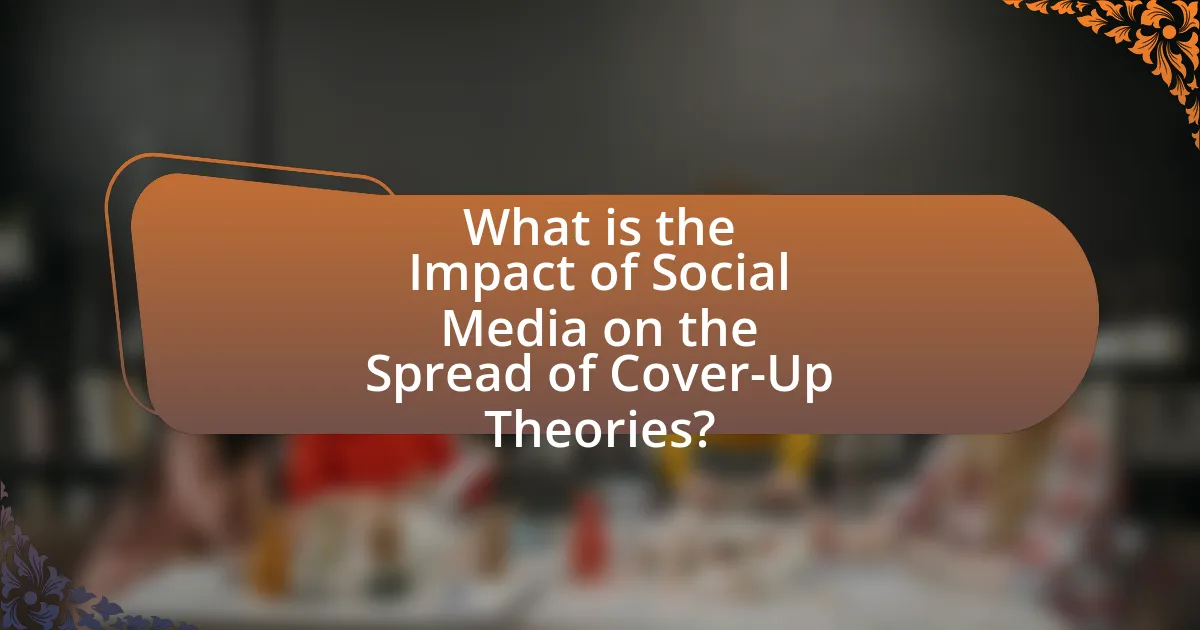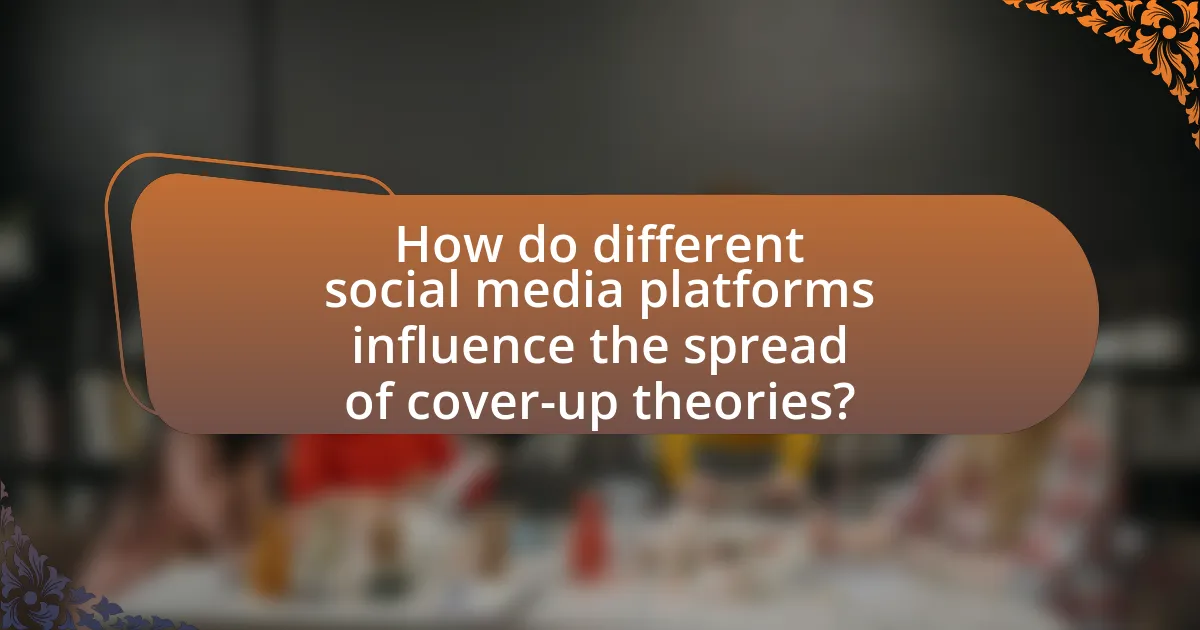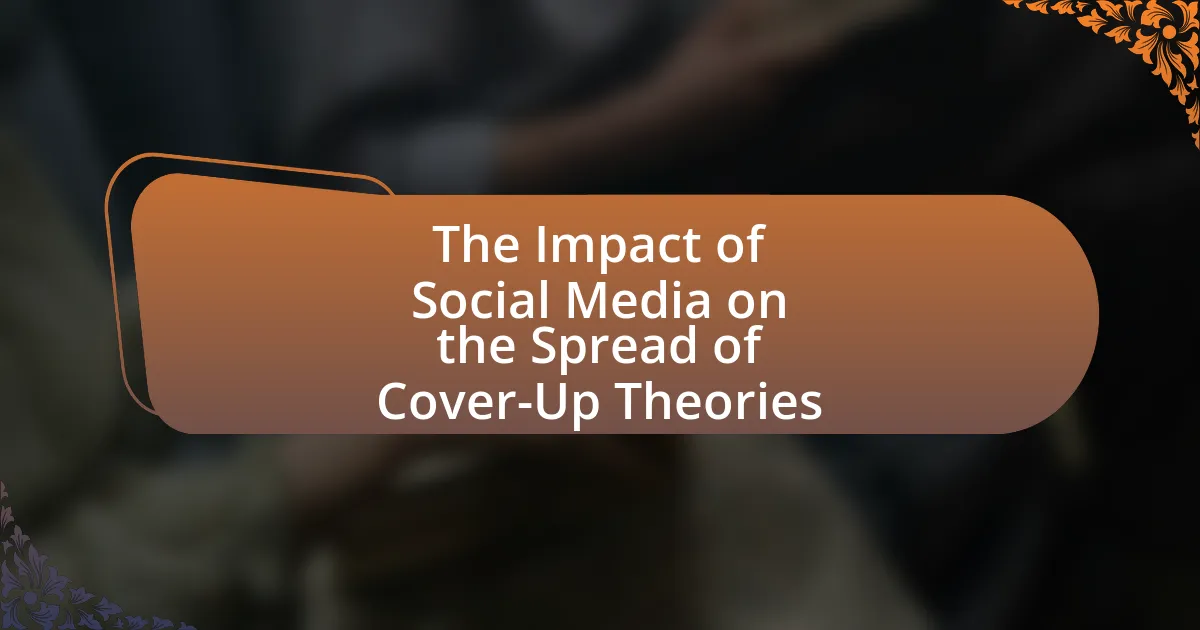The article examines the significant impact of social media on the spread of cover-up theories, highlighting how platforms facilitate rapid information dissemination and community engagement. It discusses the role of algorithms in amplifying sensational content, leading to the viral spread of misinformation, and explores the psychological factors that contribute to the acceptance of these theories. Additionally, the article addresses the consequences of believing in cover-up theories, including erosion of trust in institutions and increased societal polarization, while also considering strategies for combating misinformation through fact-checking and media literacy.

What is the Impact of Social Media on the Spread of Cover-Up Theories?
Social media significantly accelerates the spread of cover-up theories by providing a platform for rapid information dissemination and community engagement. The algorithms used by social media platforms often prioritize sensational content, which can amplify conspiracy theories and misinformation. For instance, a study published in the journal “Science” found that false news stories are 70% more likely to be retweeted than true stories, highlighting how social media can facilitate the viral spread of misleading narratives. Additionally, the interactive nature of social media allows users to share, comment, and create echo chambers, further entrenching these theories within specific communities.
How has social media changed the way cover-up theories are disseminated?
Social media has significantly accelerated the dissemination of cover-up theories by enabling rapid sharing and amplification of information among users. Platforms like Twitter and Facebook allow individuals to instantly share their beliefs and theories with a global audience, often bypassing traditional media gatekeepers. This immediacy can lead to viral spread, as seen in events like the COVID-19 pandemic, where misinformation circulated widely across social networks, influencing public perception and behavior. Additionally, algorithms on these platforms often promote sensational content, further enhancing the visibility of cover-up theories. The combination of user-generated content and algorithmic amplification creates an environment where unverified claims can gain traction quickly, making it easier for cover-up theories to proliferate.
What role do algorithms play in promoting cover-up theories on social media?
Algorithms significantly amplify cover-up theories on social media by prioritizing sensational content that engages users. These algorithms analyze user behavior, promoting posts that generate high interaction rates, such as likes, shares, and comments. Research indicates that misinformation spreads faster than factual information, with a study from MIT showing that false news stories are 70% more likely to be retweeted than true ones. This tendency is exacerbated by algorithms that favor emotionally charged content, leading to increased visibility for cover-up theories. Consequently, users are more likely to encounter and engage with these theories, reinforcing their prevalence on social media platforms.
How do user interactions influence the visibility of cover-up theories?
User interactions significantly influence the visibility of cover-up theories by amplifying their reach through engagement metrics such as likes, shares, and comments. When users actively engage with content related to cover-up theories, algorithms on social media platforms prioritize this content, leading to increased visibility in users’ feeds. For instance, a study by the Pew Research Center found that 64% of Americans believe social media has a major role in spreading misinformation, including conspiracy theories. This engagement creates a feedback loop where popular theories gain more traction, further encouraging user interaction and perpetuating their visibility.
Why are cover-up theories particularly prevalent on social media platforms?
Cover-up theories are particularly prevalent on social media platforms due to the rapid dissemination of information and the lack of rigorous fact-checking. Social media allows users to share content instantly, creating echo chambers where misinformation can thrive without scrutiny. A study by the Massachusetts Institute of Technology found that false news stories spread six times faster than true stories on Twitter, highlighting the platform’s role in amplifying sensational claims. Additionally, algorithms prioritize engaging content, often favoring conspiracy theories that provoke strong emotional reactions, further entrenching these narratives within user communities.
What psychological factors contribute to the spread of cover-up theories?
Psychological factors that contribute to the spread of cover-up theories include cognitive biases, social identity, and the need for control. Cognitive biases, such as confirmation bias, lead individuals to favor information that supports their pre-existing beliefs while dismissing contradictory evidence. Social identity influences individuals to align with groups that share similar views, reinforcing the acceptance of cover-up theories within those communities. Additionally, the need for control drives people to seek explanations for complex events, often resulting in the adoption of simpler, conspiratorial narratives. Research indicates that these psychological mechanisms are amplified by social media, which facilitates the rapid dissemination of such theories, creating echo chambers that further entrench these beliefs.
How does the anonymity of social media users affect the propagation of these theories?
The anonymity of social media users significantly enhances the propagation of cover-up theories by allowing individuals to share and endorse ideas without fear of personal repercussions. This lack of accountability encourages the spread of misinformation, as users can post sensational claims or conspiracy theories without verifying their accuracy. Research indicates that anonymity can lead to a decrease in critical thinking and an increase in impulsive sharing behaviors, which further amplifies the reach of these theories. For instance, a study published in the journal “Computers in Human Behavior” found that anonymous users are more likely to engage in negative behaviors online, including the dissemination of false information. Thus, the protective veil of anonymity fosters an environment where cover-up theories can thrive unchecked.
What are the consequences of the spread of cover-up theories on social media?
The spread of cover-up theories on social media leads to significant societal consequences, including the erosion of trust in institutions and the proliferation of misinformation. When individuals encounter these theories, they often become skeptical of credible sources, which undermines public confidence in government, media, and scientific communities. Research indicates that misinformation can spread six times faster than factual information on platforms like Twitter, exacerbating confusion and distrust among the public. Additionally, the normalization of conspiracy thinking can foster polarization, as communities become divided over conflicting narratives, further complicating social cohesion and dialogue.
How do cover-up theories impact public perception and trust in institutions?
Cover-up theories significantly diminish public perception and trust in institutions. When individuals believe that institutions are involved in concealing information, it fosters skepticism and distrust, leading to a perception that these entities prioritize self-preservation over transparency. Research indicates that exposure to conspiracy theories can result in decreased trust in government and media, as seen in studies like “The Role of Conspiracy Theories in the Erosion of Trust in Institutions” published in the Journal of Social and Political Psychology, which highlights that individuals who endorse conspiracy theories are less likely to trust official sources. This erosion of trust can have long-term implications for civic engagement and compliance with institutional directives.
What are the potential real-world implications of believing in cover-up theories?
Believing in cover-up theories can lead to significant real-world implications, including erosion of trust in institutions and increased polarization within society. When individuals accept these theories, they often become skeptical of government, media, and scientific authorities, which can undermine public health initiatives and hinder effective governance. For instance, during the COVID-19 pandemic, widespread belief in conspiracy theories about the virus’s origins and vaccine safety contributed to vaccine hesitancy, resulting in lower vaccination rates and prolonged public health crises. Additionally, such beliefs can foster social division, as communities become fragmented along lines of trust and misinformation, leading to conflicts and reduced social cohesion.

How do different social media platforms influence the spread of cover-up theories?
Different social media platforms influence the spread of cover-up theories by varying their algorithms, user engagement features, and community dynamics. For instance, platforms like Facebook and Twitter prioritize content that generates high engagement, which can amplify sensational or conspiratorial posts, leading to wider dissemination of cover-up theories. Research by the Pew Research Center indicates that 64% of Americans believe social media has a mostly negative effect on the way things are going in the country, highlighting concerns about misinformation. Additionally, platforms such as Reddit foster niche communities where users can share and validate cover-up theories, creating echo chambers that reinforce these beliefs. This combination of algorithmic promotion and community support significantly enhances the visibility and credibility of cover-up theories across different social media platforms.
What unique features of platforms like Facebook and Twitter affect theory dissemination?
Platforms like Facebook and Twitter facilitate theory dissemination through their unique features such as algorithm-driven content curation, real-time sharing capabilities, and user engagement mechanisms. Algorithm-driven content curation prioritizes posts based on user interactions, which can amplify certain theories while suppressing others, leading to echo chambers. Real-time sharing allows users to disseminate information rapidly, enabling theories to spread quickly across networks. User engagement mechanisms, such as likes, shares, and comments, create a feedback loop that can validate and promote specific theories, influencing public perception. These features collectively enhance the visibility and reach of cover-up theories, as evidenced by studies showing that misinformation spreads faster on social media than factual information.
How does the format of content (text, video, images) impact the spread of cover-up theories?
The format of content significantly impacts the spread of cover-up theories, as different formats engage audiences in distinct ways. Text-based content often provides detailed explanations and arguments, allowing for in-depth analysis, while videos can evoke emotional responses through visuals and storytelling, making theories more compelling. Images serve as powerful tools for persuasion, as they can quickly convey messages and create strong associations. Research indicates that visual content is more likely to be shared on social media, enhancing the reach of cover-up theories. For instance, a study by the Pew Research Center found that posts with images receive 94% more views than those without, illustrating how visual formats can amplify the dissemination of conspiracy theories.
What role do influencers play in promoting or debunking cover-up theories?
Influencers play a significant role in both promoting and debunking cover-up theories through their extensive reach and credibility among followers. When influencers share content that aligns with a cover-up theory, they can amplify misinformation, as seen in cases like the COVID-19 vaccine conspiracy theories, where influencers with large audiences contributed to the spread of skepticism. Conversely, influencers can also debunk these theories by providing factual information and expert opinions, as demonstrated by health influencers who countered vaccine misinformation with scientifically backed data, thereby helping to mitigate the spread of false narratives. Their ability to shape public perception makes influencers powerful agents in the discourse surrounding cover-up theories.
How do echo chambers contribute to the spread of cover-up theories on social media?
Echo chambers contribute to the spread of cover-up theories on social media by reinforcing users’ pre-existing beliefs and isolating them from opposing viewpoints. This phenomenon occurs as individuals engage primarily with like-minded peers, leading to a lack of critical scrutiny and validation of information. Research indicates that social media algorithms often prioritize content that aligns with users’ interests, further entrenching these echo chambers. A study by the Pew Research Center found that 64% of Americans believe social media has a mostly negative effect on the way things are going in the country, highlighting concerns about misinformation and the amplification of unfounded theories.
What mechanisms create echo chambers within social media networks?
Echo chambers within social media networks are primarily created through algorithms that prioritize content based on user engagement and preferences. These algorithms analyze user behavior, such as likes, shares, and comments, to curate a personalized feed that often reinforces existing beliefs. Research indicates that users are more likely to interact with content that aligns with their views, leading to a feedback loop where similar perspectives are amplified. A study by Bakshy et al. (2015) in “Proceedings of the National Academy of Sciences” found that Facebook’s algorithm significantly influences the diversity of information users are exposed to, often resulting in the isolation of differing viewpoints. Additionally, social dynamics, such as group polarization and selective exposure, further contribute to the formation of echo chambers, as individuals tend to engage with like-minded peers, thereby limiting exposure to contrasting opinions.
How do echo chambers reinforce belief in cover-up theories among users?
Echo chambers reinforce belief in cover-up theories among users by creating environments where individuals are exposed primarily to information that aligns with their pre-existing beliefs. This selective exposure fosters confirmation bias, as users encounter repeated affirmations of their views while dismissing contradictory evidence. Research indicates that social media algorithms often prioritize content that resonates with users’ interests, further entrenching these beliefs. For instance, a study by the Pew Research Center found that 64% of Americans believe that social media has a significant role in shaping their views, often leading to polarized perspectives. Consequently, echo chambers not only validate but also amplify belief in cover-up theories, making them more resilient against factual rebuttals.

What strategies can be employed to combat the spread of cover-up theories on social media?
To combat the spread of cover-up theories on social media, implementing fact-checking initiatives is essential. Fact-checking organizations, such as Snopes and FactCheck.org, actively verify claims and provide accurate information to counter misinformation. Additionally, social media platforms can enhance their algorithms to prioritize credible sources and flag misleading content, as seen in Facebook’s efforts to reduce the visibility of false information through partnerships with independent fact-checkers. Educating users about media literacy is also crucial; studies indicate that individuals who are trained to critically evaluate sources are less likely to believe in conspiracy theories. By combining these strategies, the spread of cover-up theories can be significantly mitigated.
How can social media platforms improve their policies to address cover-up theories?
Social media platforms can improve their policies to address cover-up theories by implementing stricter content moderation guidelines that specifically target misinformation and conspiracy theories. These platforms should utilize advanced algorithms and human oversight to identify and flag content that promotes unfounded cover-up theories, ensuring that such information is either removed or accompanied by fact-checking resources. Research indicates that misinformation spreads rapidly on social media, with a study by Vosoughi, Roy, and Aral (2018) in “Science” showing that false news stories are 70% more likely to be retweeted than true stories. By prioritizing transparency in their moderation processes and collaborating with independent fact-checkers, social media platforms can significantly reduce the visibility and impact of cover-up theories, fostering a more informed user base.
What role does fact-checking play in mitigating the spread of misinformation?
Fact-checking plays a crucial role in mitigating the spread of misinformation by verifying claims and providing accurate information to the public. This process helps to identify false narratives and correct misleading information before it can gain traction, particularly on social media platforms where misinformation can spread rapidly. Research indicates that fact-checking can reduce the belief in false claims by up to 70%, as seen in studies conducted by organizations like the Pew Research Center. By offering reliable sources and evidence-based corrections, fact-checking empowers individuals to make informed decisions and fosters a more informed society.
How can users identify and challenge cover-up theories effectively?
Users can identify and challenge cover-up theories effectively by critically evaluating the sources of information and cross-referencing claims with credible evidence. This involves checking the reliability of the source, such as established news organizations or academic publications, and verifying facts through multiple independent outlets. For instance, a study published in the journal “Science Communication” highlights that individuals who engage in fact-checking and seek diverse perspectives are more likely to debunk misinformation. Additionally, users should be aware of cognitive biases that may influence their perception, such as confirmation bias, which can lead to the acceptance of false narratives. By employing these strategies, users can better discern the validity of cover-up theories and contribute to informed discussions.
What best practices can individuals adopt to reduce the impact of cover-up theories?
Individuals can reduce the impact of cover-up theories by critically evaluating information sources before sharing or believing them. This practice involves verifying facts through reputable news outlets, academic research, or official statements, which helps to counter misinformation. For instance, a study by the Pew Research Center found that individuals who engage in fact-checking are less likely to believe in conspiracy theories. Additionally, promoting media literacy within communities can empower others to discern credible information, further diminishing the influence of cover-up theories.
How can critical thinking skills help users navigate social media content?
Critical thinking skills enable users to effectively evaluate and analyze social media content, distinguishing between credible information and misinformation. By applying critical thinking, users can assess the source of information, identify biases, and recognize logical fallacies, which are prevalent in cover-up theories often circulated on social media. Research indicates that individuals with strong critical thinking abilities are better equipped to question the validity of claims and seek out evidence, thereby reducing the likelihood of being misled by false narratives. For instance, a study published in the Journal of Media Literacy Education found that critical thinking training significantly improved participants’ ability to discern credible sources from unreliable ones, highlighting the importance of these skills in navigating the complex landscape of social media.
What resources are available for users to verify information related to cover-up theories?
Users can verify information related to cover-up theories through fact-checking websites, academic journals, and reputable news organizations. Fact-checking websites like Snopes and FactCheck.org provide researched analyses of various claims, including conspiracy theories. Academic journals, such as those found in databases like JSTOR or Google Scholar, offer peer-reviewed studies that can provide context and evidence regarding specific theories. Reputable news organizations, including The New York Times and BBC, often investigate and report on cover-up claims, providing reliable information based on thorough journalism. These resources collectively help users discern credible information from misinformation surrounding cover-up theories.
